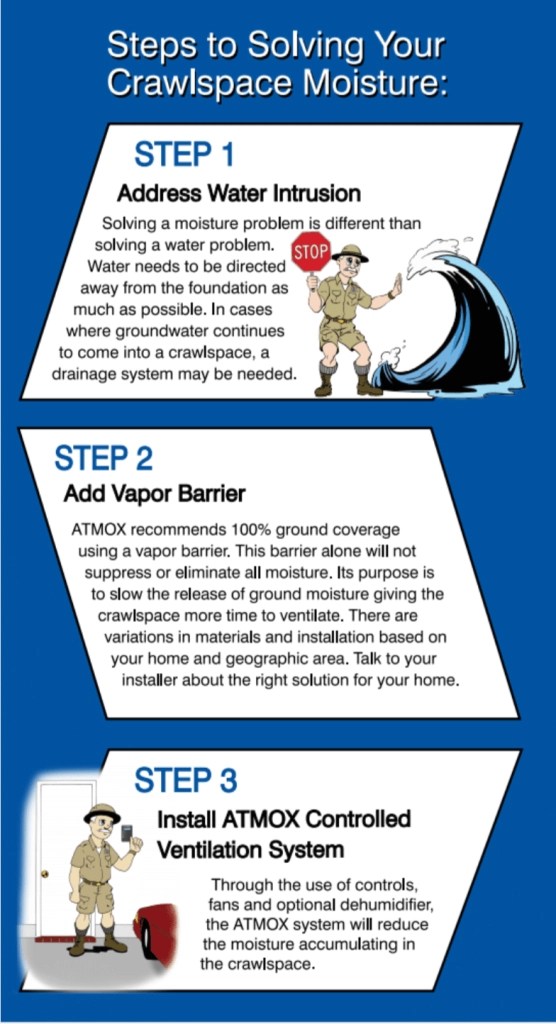
What should my crawl space humidity be?
Sounds like an easy question, but humidity is actually a little tricky and sometimes misleading. Why is that? Most people in the crawl space industry often forget that humidity is rH and that “r” is important to remember. It is really relative humidity and that “relative” refers to the humidity relative to a specific temperature. So when you are looking at humidity, it is important to also remember to look at the temperature level. This is why dew point is a better measurement – more on that below.
All that being said, here at ATMOX our focus is on wood moisture levels, which you can read about in a previous blog post. As stated there, crawl space relative humidity will fluctuate, but a good target is to keep it mostly within a range of 55% and 75%.
How do you achieve that dry crawl space?

As outlined in our crawl space overview brochure, there are 3 steps to solving moisture problems in a crawl space.
- Address Water Intrusion
- Add Vapor Barrier
- Install ATMOX System
The first two steps are important to address with your installer and important in controlling overall crawl space humidity. The third part is where the ATMOX products come in. ATMOX will use outside air when beneficial or use a dehumidifier to dry the crawl space. Setups and product selection will vary somewhat based on your crawl space needs and goals.
We’ve been suggesting these steps for years. It matches up with guidance from the EPA on Foundation Construction to implement a moisture control plan to cover:
- “Preventing high-humidity conditions when crawl spaces are enclosed by the overhead floor deck by:
- Sloping the earth in the crawl space to direct water to a disposal location; installing a vapor barrier over the earthen floor . . .
- Monitoring the relative humidity to determine whether dehumidification is needed; controlling humidity in the crawl space to less than 65 percent using ventilation, if outdoor air dew points are lower than 55 F, or with dehumidifiers.”
So back to humidity . . .
As you can see, even in this post there is a little bit of variation in target crawl space humidity. In this guidance, the EPA states 65% rH. We are giving a wider range of 55% to 75% rH. At some point theory and application have to come together, it is nearly impossible and inefficient to try to hit an exact relative humidity. It is going to vary, and that is okay. It also isn’t necessary to be so specific since the entire goal is to avoid mold and wood rot and other pests in the crawl space not really to target a set rH number. We just need the crawl space not to remain in a consistently high humidity range over a longer period of time.



Interpreting dew point . . .
Meteorologists love talking about dew point. Most of us don’t pay close enough attention to a local weather forecast on the evening news, but dew point is generally part of it especially in the summer months. Yet, we don’t really know how to interpret the numbers as we usually look at temperature. Dew point is measured in degrees just like temperature, but it also takes the humidity level into account.

Dew point gives us a much better indication of how we will feel on a summertime day beyond the temperature. We (especially those living in the Southeast) all know how icky those hot and humid days can feel. Here’s general rule of thumb from the National Weather Service on how the air feels by dew point:
- Less than 55 degrees: Dry and comfortable
- Between 55 and 65 degrees: Becoming “sticky”
- Greater than 65 degrees: Lots of moisture in the air, becoming unpleasant to oppressive
Putting crawl space humidity and dew point all together with ATMOX.
The overall goal stated by the EPA aligns with the ATMOX goal to create an ATMOXsphere. The ATMOX controller works to achieve low crawl space humidity using outside air with lower dew points and a dehumidifier when outside air isn’t beneficial. The ATMOX controller is actually a little bit more sophisticated than just looking at a simple dew point number and takes it a step further.
ATMOX doesn’t just want a good dew point – it wants a better dew point. The controller is using data from sensors both inside the crawl space and outside to calculate the dew point in both locations. It is using outside air whenever the dew point is lower outside which interprets to drier and beneficial air for the crawl space. At the same time, the controller will use a dehumidifier whenever dry outside air is not available and inside relative humidity is elevated. Settings may vary, but this is where a dehumidifier will be used to dry to the 65% rH range.


